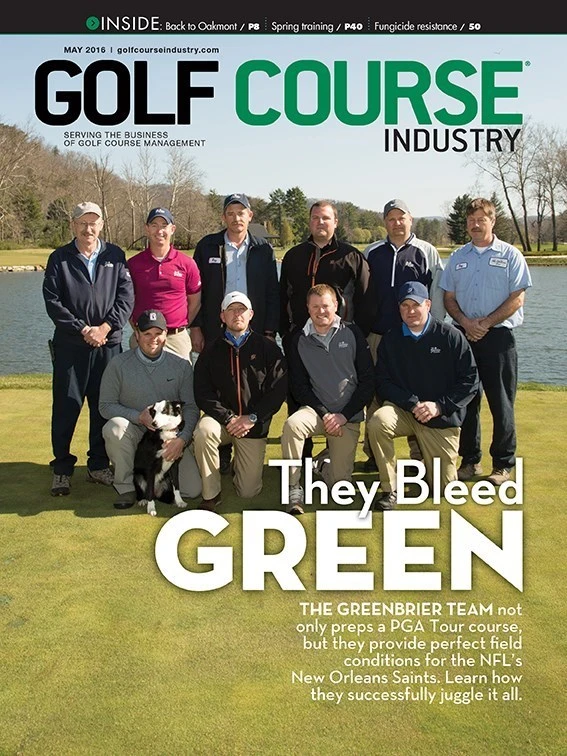
Standing beside a practice putting green that doubles as storied Oakmont Country Club’s ninth hole, superintendent John Zimmers gazes at a golf course he started managing in 1999.
The view provides few obstructions, with the only eyesore being a red-roofed convenient store beyond the club’s property. What seemed unimaginable when Zimmers arrived at Oakmont gradually has become the norm and represents the biggest change for a property offering what USGA executive director Mike Davis refers to as a bunch of “sameness” since it last hosted a U.S. Open in 2007.
Oakmont’s days as a parkland golf course are over. Zimmers can see 17 of 18 flagsticks from where he’s standing on this gorgeous late-April afternoon, which happens to be 52 days before the club hosts a record ninth U.S. Open. Zimmers estimates restoring Oakmont to resemble the vision Henry Fownes originally intended for the Western Pennsylvania property required removing 14,000 trees, including 6,500 since the 2007 U.S. Open.
If any course can host a U.S. Open on a whim, it’s Oakmont, according to Davis. The daily demands mean no respites for Zimmers, his top assistant, director of U.S. Open operations and projects David Delsandro, and the rest of 45-member turf team. But views like the one from beyond the ninth green mean maintaining championship turf is a bit easier when the weather cooperates.
“The main intent was to restore it architecturally, but the benefits are less leaves, less water, less fertility,” Zimmers says. “It has been a win-win. The grass does better with sun and wind. No complaints on my end.”
Fescue, which covers 70 to 80 acres of the 260-acre property, has replaced deep, lush rough in areas surrounding the fallen trees. The transformation has improved the growing conditions throughout the course.
“One of the biggest challenges on any golf course are growing environments, not having good air movement, not having good sunlight penetration,” USGA Green Section Director of Championship Agronomy Darin Bevard says. “It’s just not an issue at Oakmont anymore. Most of these greens are in good growing environments. It doesn’t mean that there are perfect growing conditions, but they have a lot better chance than when all of those trees are there.”
Oakmont had experienced ideal pre-major growing conditions through late April. Zimmers says the course is close to being a month ahead of where it stood at the same point in 2015. Zimmers and Delsandro break the period leading into the U.S. Open into a series of one-day tests, and firm April turf represented an encouraging sign. The dry early spring followed a mild winter by Western Pennsylvania standards. Still, avoiding complacency has helped Oakmont develop one of the industry’s model turf departments, and Zimmers says much can change between late April and June 16, especially if soggy weather interrupts the construction of U.S. Open infrastructure.
Rain also might be the only obstacle preventing a punishing championship. Davis says Oakmont will play to the same yardage with the same fairway widths and contours, jarring green speeds, deep grass heights, penal bunkering and “wonderful course condition” as it did in 2007. Angel Cabrera won the tournament with a four-day score of 5 over par.
Everything about Oakmont contrasts the past two U.S. Open sites Pinehurst and Chambers Bay. Davis and the USGA used both venues as a forum to demonstrate less irrigation and more brown can yield championship turf. The appearance of both courses shocked many golf fans and caused mixed reactions within the turf community.
A different message should emulate from Oakmont, which Davis says “meets the gold standard of a rigorous championship test.” Oakmont’s greens, tees, fairways and primary rough look as green as ever, but the stunning aesthetics are being accomplished in leaner ways. Besides areas requiring less water and fertility, Oakmont has added mowers with hybrid technology to its fleet, incorporated more data into its agronomic program and increased its volume of hand watering.
“We are not going to look like Chambers Bay or Pinehurst. We can’t look like Chambers Bay. We can’t look like Pinehurst,” Zimmers says. “We are going to be Oakmont. We have different soils. We have different grasses. I think the general public should understand that. They are on sand-based soils. We are on clay-based soils. All of those things have a huge impact. We have a great story. Our story is we have fescues, we have used less inputs, less water, less fertility. All of that kind of ties together, just different aspects. It’s a different piece of property.”
Get curated news on YOUR industry.
Enter your email to receive our newsletters.
Explore the May 2016 Issue
Check out more from this issue and find your next story to read.
Latest from Golf Course Industry
- GCSAA’s Health in Action 5K/2K reaches fundraising goal
- Landscapes Golf Management to participate in data analyzation initiative
- Reel Turf Techs: Carl Michael
- Atlanta Athletic Club approves funding for master plan
- Maximizing Cultural Practices and Agronomic Benefits with Minimal Surface Disruption
- Real Answers about Spray Nozzle Choices
- From the Course to the Factory: How Customer Insights Drive Innovation
- New & Proven Enzyme Strategies for Sprayable Thatch Management





